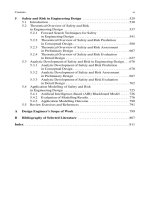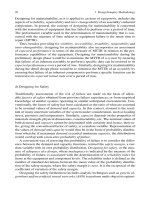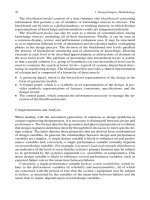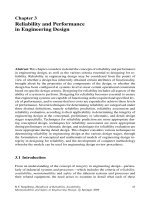Handbook of Reliability, Availability, Maintainability and Safety in Engineering Design - Part 9 potx
Bạn đang xem bản rút gọn của tài liệu. Xem và tải ngay bản đầy đủ của tài liệu tại đây (136.59 KB, 10 trang )
3.2 Theoretical Overview of Reliability and Performance in Engineering Design 63
Cost estimating concepts The two basic categories of costs that must be consid-
ered in engineered installations are recurring costs and non-recurring costs.Anex-
ample of a non-recurring cost would be the engineering design of a system from its
conceptual design through preliminary design to detail design. A typical recurring
cost would be the construction, fabrication or installation costs for the system during
its construction/installation phase.
Estimating non-recurring costs In making cost estimates for non-recurring costs
such as the engineering design of a system from its conceptual design through to
final detail design, inclusive of first costs and risk costs, the project manager may
assign the task of analysing the scope of engineering effort to the cognisant en-
gineering design task force group leaders. This engineering effort would then be
divided into two definable categories, namely a conceptual effort, and a design ef-
fort.
Conceptual effort The characteristic of conceptual effort during the conceptual
design phase is that it requires creative engineering to apply new areas of technol-
ogy that are probed in feasibility studies, in an attempt to solve a particular design
problem. However, creative engineering contains more risk to complete as far as
time and cost are concerned, and the estimates must therefore be modified by the
proper risk factor.
Design effort The design effortinvolvesstraightforwardengineeringwork in which
established proceduresare used to achieve the design objective. The estimate of cost
and time to complete the engineering work during the preliminary design and final
detail design phases can be readily derived from past experience of the design en-
gineers, or from the history of similar projects. These estimates should eventually
be accurate within 10% of completed construction costs, requiring estimates to be
modified by a smaller but still significant risk factor.
Classification of engineering effort In a classification of the type of engineering
effort that is required, the intended engineered installation would be subdivided into
groups of discrete elements, and analysed according to b lock diagramsof these basic
groups of elements that comprise the proposed design. The elements identified in
each block would serve as a logical starting point for the work breakdown structure
(WBS), which would then be u sed for deriving the cost estimate. These elements can
be grouped into:
• Type A: engineered elements:
Elements requiringcost estimates for engineering design, as well as for construc-
tion/fabrication and installatio n (i.e. contractor items).
• Type B: fabricated elements:
Elements requiring cost estimates for fabrication and installation only (i.e. ven-
dor items or packages).
• Type C: procured elements:
Elements requiring cost estimates for procurement and drafting to convey sys-
tems inter face only (i.e. off-the-shelf items).
64 3 Reliability and Performance in Engineering Design
Each of the elements would then be classified as to the degree of design detail re-
quired. (That is to achieve the requirements stipulated by the design baseline iden-
tified in a design configuration management plan.) The classification is based on
the degree of engineering effort required by the design engineer, and will vary in
accordance with the knowledge in a particular field of technology. Those elements
that require a significant amount of engineering and drafting effort are th e systems
and sub-systems that will be designed, built and tested, requiring detailed drawings
and specifications. In most engineered installations, type A elements represent about
30% of all the items but account for about 70% of the total effort required.
Management review of engineering effort When the estimates for the various
elements are sub mitted by the different engineers, a cost estimate r eview by task
force senior engineers, the team leader, and project manager includes:
• A review of all systems to identify similar or identical elements for which redun-
dant engineering charges are estimated.
• A review of all systems to identify elements for which a design may have been
accomplished on other projects, thereby making available an off-the-shelf design
instead of expending a duplicating engineering effort on the current project.
• A review of all systems to identify elements that, although different, may be
sufficiently similar to warrant adopting one standard element for a maximum
number of systems without compromising the performance characteristics of the
system.
• A review of all systems to identify elements that may be similar to off-the-shelf
designs to warrant adoption of such off-the-shelf designs without compromising
the performance characteristics in any significant way.
Estimating recurring costs Some of the factors that comprise recurring cost esti-
mates for the construction/installation phase of a system are the following:
• Construction costs, including costs of site establishment, site works, general con-
struction, system support structures, on-site fabrication, inspection, system and
facilities construction, water supply, and construction support services.
• Fabrication costs, including costs of fabricating specific systems and assemblies,
setting up specialised manufacturing facilities, manufacturing costs, quality in -
spections, and fabrication support services.
• Procurement costs, including costs of acquiring material/components, warehous-
ing, demurrage, site storage, handling, transport and inspection.
• Installation costs, including costs of auxiliary equipment and facilities, cabling,
site inspections, installation instructions, and installation drawings.
The techniques and thinking process required to estimate the cost of engineered in-
stallations differ greatly from normal construction cost estimations. Before project
engineers can b egin to converge on a cost estimate for a system or facility of an en-
gineered installation, it must be properly defined, requiring answers to the following
types of questions:
What is the description and specification of each system?
What is the description and specification of each sub-system?
3.2 Theoretical Overview of Reliability and Performance in Engineering Design 65
Pitfalls of cost estimating The major pitfalls of estimating costs for engineered
installations are errors in applying the mechanics of estimating,as well asjudgement
errors. In deriving the cost estimate, project engineers should review the work to
ensure that none of the following errors has been made:
• Omissions and incorrect work breakdown:
Was any cost element forgotten in addition to the engineering, material or other
costs estimated for the engineering effort? Does the work breakdown structure
adequately account for all the systems/sub-systems and engineering effort re-
quired?
• Misinterpretation of data:
Is the interpretation of the complexity of the engineered installation accurate?
Interpretations leading to under-estimations of simplicity or over-estimations of
complexity will result in estimates of costs that are either too low or too high.
• Wrong estimating techniques:
The correct estimating techniques must be applied to the project. For example,
the use of cost statistics derived from the construction of a similar system, and
using such figures for a system that requires engineering will invariably lead to
low cost estimates.
• Failure to identify major cost elements:
It has been statistically established that for any system, 20% of its sub-systems
will account for 80% of its total cost. Concentration o n these identified sub-
systems will ensure a reasonable cost estimate.
• Failure to assess and pr ovide for risks:
Engineered installations involving engineering and design effort must be tested
for verification. Such tests usually involve a high expenditure to attain the final
detail design specification.
3.2.1.2 Interference Theory and Reliability Modelling
Although, at the conceptual and preliminary design phases, the intention is to con-
sider systems that fulfil their required performance criteria within specified limits of
performance according to the functional characteristics of their constituent assem-
blies, further design considerations of process systems may include the component
level. This is done by referring to the collective reliabilities and physical configu-
rations of components in assemblies, depending on what level of process definition
has been attained, and whether component failure rates are known. However, some
component failures are not necessarily dependent upon usage over time, especially
in specific cases of electrical components. In such cases, generally a failure occurs
when the stress exceeds the strength. Therefo re, to predict reliability of such items,
the nature of the stress and strength random variables must be known. This method
assumes that the probability density functions of stress and strength are known, and
the variables are statistically independent.
66 3 Reliability and Performance in Engineering Design
Fig. 3.13 Stress/strength diagram
A stress/strength interference diagram is shown in Fig. 3 .13. The darkened area
in the diagram represen ts the interference area. Besides such graphical presentation,
it is also necessary to define the differences between stress and strength.
Stress is defined as “the load which will produce a failure of a component or de-
vice”. The term load may be identified as mechanical, electrical, thermal or en-
vironmental effects.
Strength is defined as “the ability of a component or device to accomplish its re-
quired function satisfactorily without a failure when subject to external load”.
Stress–strength interference reliability is defined as “the probability that the failure
governing stress will not exceed the failure governing strength”.
In mathematical form, this can be stated as
R
C
= P(s < S)=P(S > s) , (3.3)
where:
R
C
= the reliability of a component or a device,
P = the probability,
S = the strength,
s = the stress.
Equation (3.3 ) can be rewritten in the following form
R
C
=
+∞
−∞
f
2
(s)
⎡
⎣
∞
S
f
1
(S)dS
⎤
⎦
ds , (3.4)
3.2 Theoretical Overview of Reliability and Performance in Engineering Design 67
where:
f
2
(s) is the probability density function of the stress, s
f
1
(S) is the probability density function of the strength, S.
Models employed to predict failur e in predominantly mechanical systems are quite
elementary. They are based largely on techniques developed m any years ago for
electronic systems and components. These models can be employed effectively for
analysis of mechanical systems but they must be used with caution, since they as-
sume that extrinsic factors such as the frequency of random shocks to the system
(for example, power surges) will determine the probability of failure—hence, the
assumption of Poisson distribution processes and constant hazard rates.
In research conducted into mechanical reliability (Carter 1986), it is shown that
intrinsic degradation mechanisms such as fatigue, creep and stress corrosion can
have a strong influence on system lifetime and the probability of failure. In highly
stressed equipment, cumulative damage to specific components will be the most
likely cause of failure. Hence, a review of the factors that influence degradation
mechanisms such as maintenance practice and operatingenvironment becomes a vi-
tal element in the evaluation of likely reliability performance.
To predict the probability of system failure, it becomes necessary to identify the
various degradation mechanisms, and to determine the impact of different mainte-
nance and operating strategies on the expected lifetimes, and level of maintainabil-
ity, of the different assemblies and components in the system. The load spectrum
generated by different operating and maintenance scenarios can have a significant
effect on system failure probability.
When these distributions are well separated with small variances (low-stress con-
ditions), the safety margin will be large and the failure distribution will tend towards
the constant hazard rate (random-failure) m odel. In this case, the system failure
probability can be computed as a function of the hazard r ates for all the components
in the system. For highly stressed equipment operating in hostile environments, the
load and strength distributions may have a significant overlap because of the greater
variance of the load distribution and the deterioration in component strength with
time. Carter shows that the safety margin will th en be smaller, and the ten dency
will be towards a weakest-link model. The probab ility of failure in this case can
then depend on the resistance of one specific component (the weakest link) in the
system.
Carter’s research has been published in a number of papers and is summarised in
his book Mechanical reliability (Carter 1986). Essentially, this work relates failure
probability to th e effect of the interaction between the system’s load and strength
distributions, as indicated in Fig. 3.14. Carter’s research work also relates reliability
to design (Carter 1997).
68 3 Reliability and Performance in Engineering Design
Fig. 3.14 Interaction of load
and strength distributions
(Carter 1986)
3.2.1.3 System Reliability Modelling Based on System Performance
The techniques for reliability prediction have been selected to be appropriate during
conceptual design. However, at both the conceptual and preliminary design stages,
it is often necessary to consider only systems, and not components, as most of the
system’s components have not yet been defined. Although reliability is generally
described in terms of probability of failure or a mean time to failure of items o f
equipment (i.e. assemblies or components), a distinction is sometimes made be-
tween the performance of a process or system and its reliability. For example, pro-
cess performancemay be measured in termsof output quantities and productquality.
However, this distinction is not helpful in process design because it allows for omis-
sion of reliability prediction from conceptual design considerations, leaving the task
of evaluating reliability until d etail design, when most of the equipment has been
specified.
3.2 Theoretical Overview of Reliability and Performance in Engineering Design 69
In a paper ‘An approach to design for reliability’ (Thompson et al. 1999), it is
stated that designing for reliability includes all aspects of the ability of a system to
perform, according to the following definition:
Reliability is defined as “ the probability that a device, machine or system will per-
form a specified function within prescribed limits, under given environmental
conditions, for a specified time”.
It is apparent that a clearer d istinction between systems, equipment, assemblies and
components (not to mention devices and machines) needs to be made, in order to
properly accommodate reliability predictions in engineering design reviews. Such
a distinction is based upon the essential study and applicationof systems engineering
analysis.
Systems engineering analysis is the study of total systems performance, rather
than the study of the parts. It is the study of the complex whole of a set of connected
assemblies or components and their related properties. This is feasible only through
the establishmen t of a systems breakdown structure (SBS).
The most important step in reliability prediction at the conceptual design stage is
to consider the fir st item given in the list of essential preliminaries to th e techniques
that should be used by design engineers in determining the integrity of engineering
design, namely a systems breakdown structure (SBS; refer to Section 1.1.1; E ssen-
tial preliminaries, page 13).
a) System Breakdown Structure (SBS)
A systems breakdown structure (SBS) is a systematic hierarchical representation of
equipment, grouped into its logical systems, sub-systems, assemblies, sub-assemb-
lies and component levels. It provides visibility of process systems and their con-
stituent assemblies and components, and allows for the whole range of reliability
analysis, from reliability prediction through reliability assessment to reliability eval-
uation, to be summarised from process or system level, down to sub-system, assem-
bly, sub-assembly and component levels.
The various levels of a systems breakdown structure are normally determined
by a framework of criteria established to logically group similar components into
sub-assemblies or assemblies, which are logically grouped into sub-systems or sys-
tems. This logical grouping of the constituent parts of each level of an SBS is done
by identifying the actual physical design configuration of the various items of one
level of the SBS into items of a higher level of systems hierarchy, and by defining
common operational and physical functions of the items at each level.
Thus, from a process design integrity viewpoint, the various levels of an SBS can
be defined:
• A process consists of one or more systems for which overall availability can
be determined, and is dependent upon the interaction of the performance of its
constituent systems.
70 3 Reliability and Performance in Engineering Design
• A system is a collection of sub-systems and assemblies for which system perfor -
mance can be determined, and is dependent upon the interaction of the functions
of its constituent assemblies.
• An assembly or equipment is a collection of sub-assemblies o r components for
which the values of reliability and maintainability relating to their functions can
be determined,and is dependentupon the interaction of the reliabilities and phys-
ical configuration of its constituent components.
• A component is a collection of parts that constitutes a functional unit for which
the physical condition can be measured and reliability can be determined.
Several different terms can be used to describe an SBS in a systems engineering
context, specifically a systems hierarchical structure,orasystems hierarchy.From
an engineering design perspective, however, the term SBS is usually preferred.
b) Functional Failure and Reliability
At the componentlevel, physicalconditionand reliability arein most cases identical.
Consider the case of a coupling. Its physical condition may be measured by its
ultimate shear strength. However, the reliability of the coupling is also determined
by its ability to sustain a given torque. Similar arguments may be put for other
cases, such as a bolt—its measure of tensile strength and reliability in sustaining
a given load, in which very little difference will be found between reliability and
physical condition at the component level. When components are combined to form
an assembly, they gain a collective identity and are able to perform in a manner that
is usually more th an the sum of their parts.
For example, a positive displacement pump is an assembly of components, and
performs duties that can be measured in terms such as flow rate, pressure, tempera-
ture and power consumption. It is the ability of the assembly to carry out all these
collective functions that tends to be described as the performance, while the reli-
ability is determined by the ability of its components to resist failure. However, if
the pump continues to operate but does not deliver the correct flow rate at the right
pressure, then it should be regarded as having failed, because it does not fulfil its
prescribed duty. It is thus incorrect to describe a pump as reliable if it does not per-
form the function required of it, according to its design. This principle is based upon
a concise approach to the concept of functional failure whereby reliability, failure
and function need to be defined.
According to the US Military Standard MIL-STD-721B, reliability is defined as
“the probability that an item will perform its intended function [without failure] for
a specified interval under stated conditions”. From the same US Military Standard
MIL-STD-721B, failure is defined as “ the inability of an item to function within its
specified limits of performance”.
This means that functionalperformance limits must be clearly defined before fail-
ures can be identified. However, the task of defining functional per formance limits
is not exactly straightforward, especially at systems level. A complete analysis of
complex systems normally requires that the functions of the various assemblies and
3.2 Theoretical Overview of Reliability and Performance in Engineering Design 71
components of the system be identified, and that limits of performance be related to
these functions.
The definition of function is given as “the work that an item is designed to per-
form”. Failure of the item’s function by defin ition means failure of the work or duty
that the item is designe d to perform.
Functional failure can thus be defined as “the inability of an item to carry-out the
work that it is designed to perform within specified limits of performance”.
From the definition, two degrees of severity for functional failure can be discerned:
• A complete loss of function , where the item cannot carry out any of the work that
it was d esigned to perform.
• A partial loss of function, where the item is unable to function within specified
limits of performance.
From the definitions, a concise definition of reliability can be considered:
Reliability maybedefinedas“the probability that an item is able to carry-out the
work that it is designed to perform within specified limits of performance for
a specified interval under stated conditions”.
An important part of this definition of reliability is the ability to perform within
specified limits. Thus, from the point of view of the degrees of severity of functional
failure, no distinction is made between performance and reliability of assemblies
where functional characteristics and functional performance limits can be clearly
defined. Design considerations of process systems may refer to the component level
and/or to the collective reliabilities and physical configurations of componentsin as-
semblies, depending on what level of process definition has been attained. However,
at the conceptual or preliminary design stages, the intention is to consider systems
that fulfil their req uired performance criteria within specified lim its of performance
according to the functional characteristics of th e ir constituent assemblies.
c) Functional Failure and Functional Performance
A method in which design problems may be formulated in order to achieve maxi-
mum reliability (Thompson et al. 1999) has been adapted and expanded to accom-
modate its use in preliminary design, in which most of the system’s components
have not yet been defined. The method integrates functional failure and functional
performance considerations so that a maximum safety margin is achieved with re-
spect to all performance criteria. The most significant advantage of this method is
that it does not rely on failure data. Also, provided that all the functional perfor-
mance limits can be defined, it is possible to compute a multi-objective optimisation
to determine an optimal solution.
The conventional reliability method wou ld be to specify a minimum failure rate
and to select appropriate components with individual failure rates that, when com-
bined, achieve the required reliab ility. This method is, of course, reasonable pro-
vided that dependable failure rates are available. In many cases, however, none are
72 3 Reliability and Performance in Engineering Design
known with confidence, and a quantified approach to designing for reliability that
does not requirefailure rate data is proposed. The approach taken is to define perfor-
mance objectives that, when met, achieve an optimum design with regard to overall
reliability by ensuring that the system has no ‘ w eak links’, whether the weaknesses
are defined functional failures, or a failure of the system to meet the required per-
formance criteria. The choice of functional performance limits is made with respect
to the knowledge of loading conditions, the consequences of failure, as well as re-
liability expectations. If the knowledge of loading conditions is incomplete, which
would generally be the case for conceptual or preliminary design, the approach to
designing for reliability would be to use high safety margins, and to adopt limits of
acceptable performance that are well clear of any failure criteria. Where precise data
may not be available, it is clear from the previous consideration of strength and load
distributions under interference theory and reliability modelling that the strength
should be separated from the load by as much as possible, in order to maximise the
safety margin in relation to certain perfor mance criteria.
However, in cases where confidence can be placed on accurate loading calcula-
tions, as with the modelling situations considered in interferenc e theory or in relia-
bility modelling, then acceptable performance levels can be selected at high stress
levels so that all the components function near their limits, resulting in a high per-
formance system. If, on the other hand, it is required to reduce a safety margin with
respect to a particular failure criterion in order to introduce a ‘weak link’, then the
limits of acceptable performance can be modified accordingly. By the use of sets
of constraints that d escribe the boundaries of the limits of acceptable p erformance,
a feasible design solution will lie within the space bounded by these constraints. The
most reliable design solution would be the solution that is the furthest away from
the constraints, and a design that has the highest safety margin with respect to all
constraints is the most reliable. The objective, then, is to produce a design that has
the highest possible safety margin with respect to all constraints. However, since
these constraints will be defined in different units, and because many different con-
straints may apply, consideration of a method of measurement is required that will
yield common, non-dimensional performance measures that can be meaningfully
combined. A method of data point generation based on limits of performance has
been developed for general design analysis to determine various design alternatives
(Liu et al. 1996).
3.2.2 Theoretical Overview of Reliability Assessment
in Preliminary Design
Reliability assessment attempts to estimate the expected reliability and criticality
values for each individual system or assembly at the upper systems levels of the sys-
tems breakdown structure (SBS). This is done without any difficulty, not only for
relatively simple initial system configurations but for progressively more complex
integrations of systems as well. Reliability assessment ranges from estimations of









